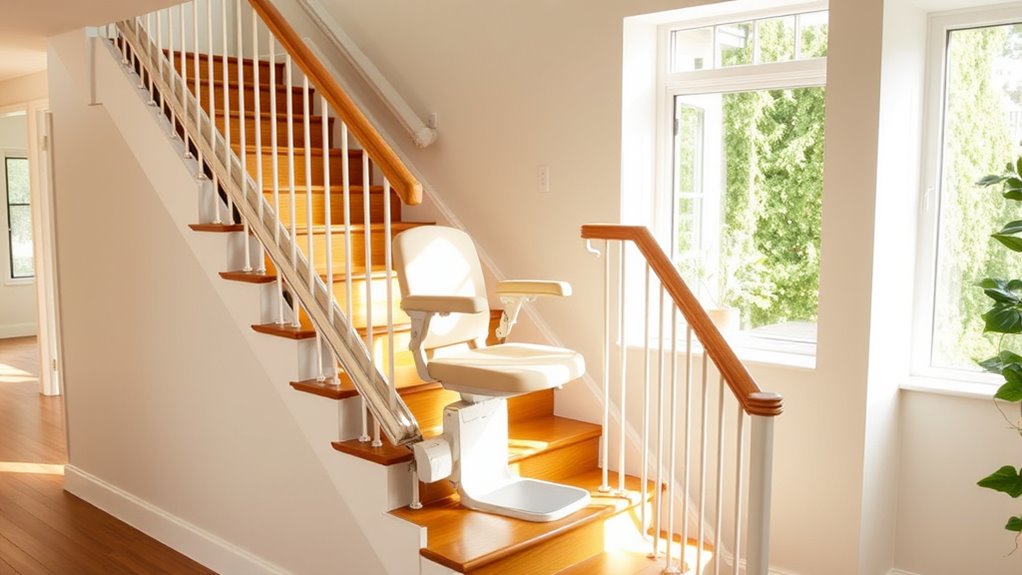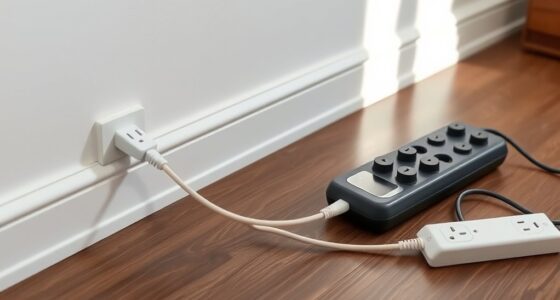To choose the right stairlift for your home, start by evaluating your staircase’s type, layout, and space. Measure the length, width, and turns to determine if a straight or curved model fits best. Consider your mobility needs and any aesthetic preferences, ensuring the lift integrates seamlessly. Plan for installation and maintenance to keep it safe and reliable. For more tips on making the best choice, keep exploring how to match your home’s unique features.
Key Takeaways
- Identify whether your stairs are straight, curved, or multi-level to select the appropriate stairlift type.
- Measure staircase dimensions, including width, length, and height, to ensure proper fit and safety.
- Consider space availability and home aesthetics to choose a model that integrates seamlessly.
- Evaluate safety features and controls tailored to your mobility needs for maximum independence.
- Budget for installation, maintenance, and long-term use to select a cost-effective, reliable stairlift.
Assessing Your Staircase Type and Layout
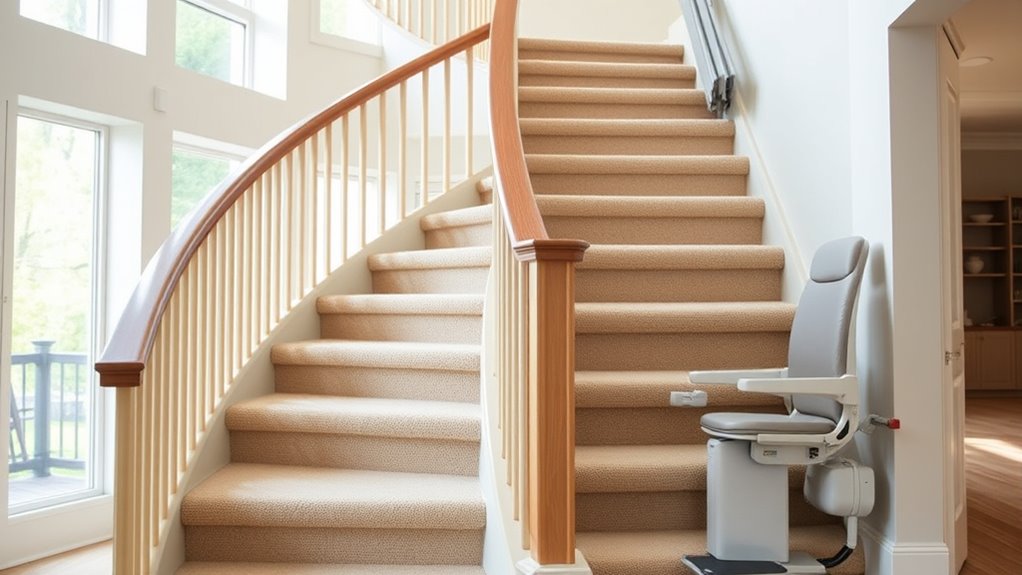
Before choosing a stairlift, you need to understand your staircase’s type and layout, as these factors directly influence which models are suitable. Knowing whether you have a straight, curved, or multi-level staircase helps determine the best fit for your home safety and aesthetic integration. Straight stairlifts are simpler and often more affordable, fitting most linear staircases without major modifications. Curved or custom stairlifts are designed to navigate complex layouts, ensuring safety and smooth operation. Considering your staircase’s dimensions and structure helps prevent awkward fits or visual disruptions, maintaining your home’s aesthetic appeal. Proper assessment of home layout considerations ensures you choose a stairlift that complements your living space effectively. Additionally, understanding the different arc types and configurations can help you select a stairlift that offers customized solutions and optimal performance tailored to your specific home structure. Being aware of building materials and finishes can also influence the choice of stairlift to ensure seamless integration with existing decor. Moreover, evaluating staircase measurements accurately is crucial for a perfect fit and safe operation.
Understanding Different Stairlift Designs
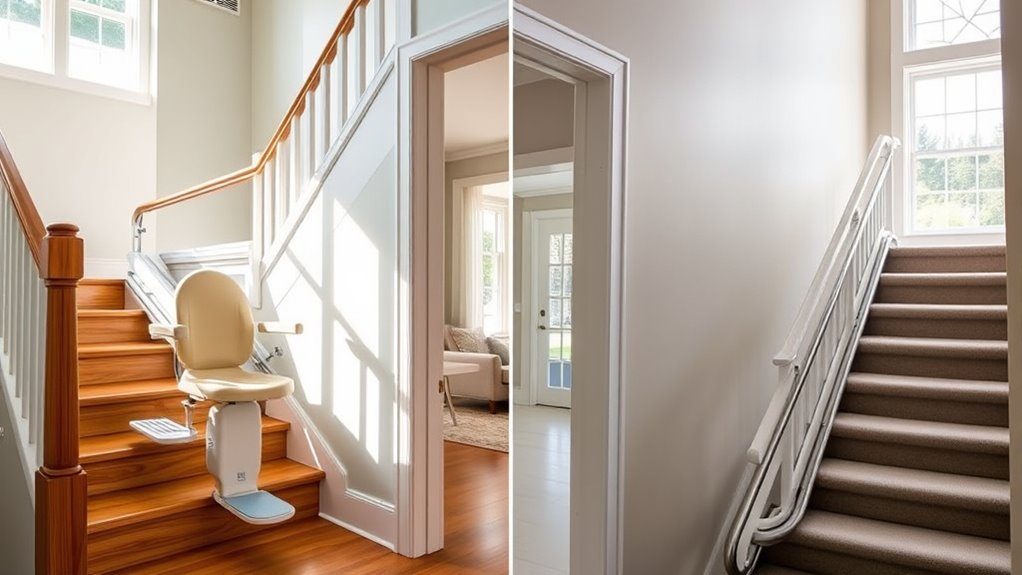
Understanding the different designs of stairlifts helps you choose the right model for your home and mobility needs. There are straight, curved, and outdoor stairlifts, each tailored to specific staircase layouts. Straight stairlifts are simple, cost-effective, and easy to install, fitting most linear stairs. Curved stairlifts follow your staircase’s unique shape, requiring custom design but offering seamless comfort. Outdoor models are built with weatherproof features for exterior stairs. Prioritizing stairlift safety ensures stability and secure seating during use. An ergonomic design enhances comfort and ease of operation, reducing fatigue and strain. Additionally, AI security advancements in monitoring and safety features can help ensure your stairlift technology remains secure and reliable. Incorporating safety features such as sensors and emergency stop functions is essential to prevent accidents and enhance user confidence. Advances in technology continue to improve the safety and usability of stairlifts, making them more reliable and user-friendly. Moreover, understanding staircase design considerations can help you select a stairlift that perfectly fits your home’s unique layout. Being aware of automatic safety features, such as obstacle detection and automatic brakes, can further improve the overall safety of your stairlift. By understanding these variations, you can select a stairlift that provides ideal safety, comfort, and functionality for your home environment.
Measuring Your Stairs for Proper Fit
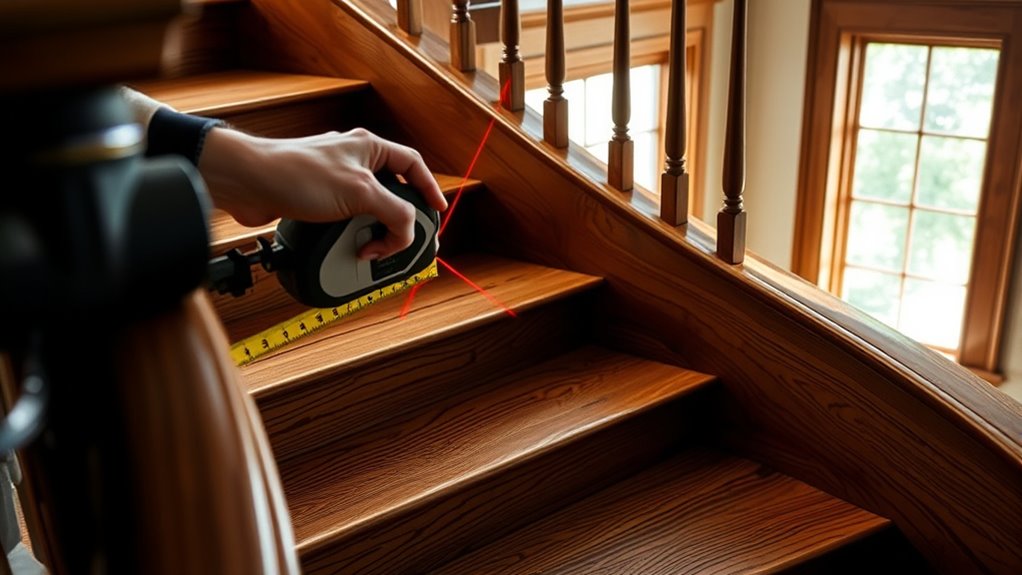
Accurately measuring your stairs is crucial to guarantee the stairlift fits safely and operates smoothly. Begin by measuring the total length of the staircase, from the bottom to the top landing. Next, record the width of the stairs at multiple points to ensure enough space for the chair and armrests. Check the height of each step to confirm compatibility with the stairlift’s footrest and ergonomic design. Don’t forget to measure the angle or pitch of your stairs, as steepness impacts the stairlift’s operation and safety. Proper measurements are essential for stairlift safety, preventing accidents or malfunctions. Taking precise measurements ensures the chair will fit comfortably and function seamlessly, giving you peace of mind and a smooth ride every time. Additionally, considering the staircase’s curvature or turn can influence the type of stairlift most suitable for your home. Ensuring you understand the installation requirements in advance can help avoid surprises during setup and ensure a proper fit. Being aware of staircase modifications that may be necessary can also help in planning the installation process effectively. Moreover, understanding the different stairlift models available can help you choose the most suitable option for your specific staircase configuration. Conducting thorough measurements and assessments can also prevent costly errors during installation.
Considering Space and Accessibility Needs

Before choosing a stairlift, you need to take into account your space and accessibility needs. Measure your stairs carefully to guarantee the lift fits comfortably and check that it works with your layout. Think about who will use the lift and explore options that accommodate all users and your home’s design. Additionally, considering the best stairlift options can help you select a model that fits your specific layout and personal requirements. It’s also important to evaluate the space optimization techniques available to ensure the stairlift integrates seamlessly into your home without sacrificing functionality or aesthetics. Consulting trusted brand information and reviews can help you choose a reliable and trustworthy model. Properly maintaining your stairlift, such as regularly checking for wear on mechanical parts, can also prolong its lifespan and ensure safety. Incorporating lifestyle considerations can further help you choose a stairlift that aligns with your daily routines and long-term needs.
Space Requirements and Measurements
Ensuring your stairlift fits comfortably requires careful measurement of the available space and consideration of accessibility needs. First, measure the width of your staircase, accounting for any architectural features and staircase acoustics that could affect installation. Second, check the length and angle of your stairs to ensure the chosen model can navigate the incline smoothly. Third, consider the stairlift’s color options to match your home’s decor without overwhelming the space. Keep in mind, some stairlift models require additional clearance for doorways or landings. Accurate measurements help prevent obstructions and guarantee a seamless fit. Taking these steps ensures your stairlift will operate smoothly and blend well with your home’s layout.
Accessibility for All Users
To make your stairlift accessible and comfortable for all users, it’s essential to contemplate both space and individual mobility needs. Accessibility features, such as swivel seats, armrests, and footrest sensors, enhance user comfort and safety. These features accommodate various mobility levels, ensuring that everyone can use the stairlift with ease. When choosing a model, consider the specific needs of all users, including those with limited balance or strength. Properly designed controls and adjustable seats also promote independence. By prioritizing these accessibility features, you create a more inclusive environment that supports safe and comfortable use, regardless of mobility challenges. Ultimately, thoughtful consideration of accessibility helps ensure your stairlift serves everyone effectively.
Layout Compatibility and Options
Choosing a stairlift that fits your space begins with understanding your staircase’s layout and dimensions. This ensures you select a model that integrates smoothly with your home. Consider these key factors:
- Space constraints – Measure width and length to find a compatible stairlift, whether straight or curved.
- Design flexibility – Many stairlifts offer aesthetic design options, including custom color choices, to match your decor.
- Accessibility needs – Determine if you need additional features like wider seats or foldable footrests for easier access.
Choosing Between Straight and Curved Models
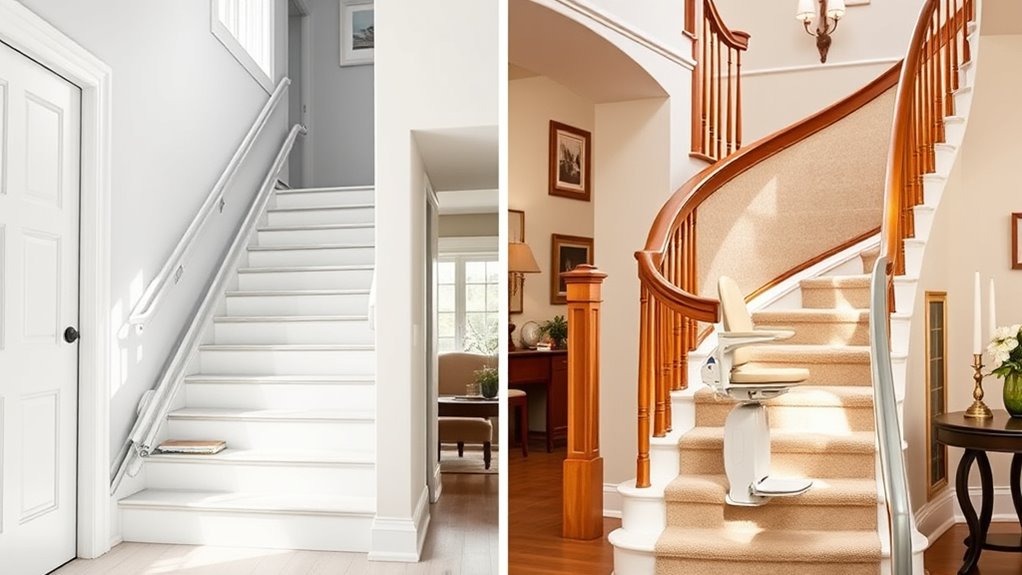
When choosing between straight and curved stairlifts, consider the space available and how complex the installation will be. Straight models are simpler and quicker to install, making them ideal for standard staircases. Curved models require more planning and space, especially for custom bends, which can influence your decision.
Space Requirements
Have you considered how space constraints influence your stairlift options? If your staircase has limited width or intricate curves, a curved stairlift might be necessary, but it requires more space and custom fitting. For straight stairs, a simple, space-efficient model works well and often fits seamlessly into your decor. When evaluating space requirements, keep these points in mind:
- Straight models usually need less room and are easier to install.
- Curved models follow your staircase’s unique shape but may require extra space for smooth operation.
- Both options should complement your decor and aesthetic considerations, ensuring the stairlift blends into your home’s style without feeling intrusive.
Understanding your space helps you choose a model that fits comfortably and looks great.
Installation Complexity
Installing a straight stairlift is generally straightforward and quick because it requires minimal modifications to your staircase. Since there are no curves or landings, the installation process is simpler, often completed within a few hours. Curved stairlifts, on the other hand, involve custom railings shaped to your staircase’s unique layout, making installation more complex and time-consuming. You’ll need to take into account safety regulations to make sure the lift is securely installed and operates safely. Additionally, check how warranty coverage differs between models; straight stairlifts often have broader coverage due to simpler installation, while curved models may have more limited warranties because of their custom nature. Ultimately, your choice will depend on your home’s layout and your comfort with the installation process.
Evaluating Power Options and Battery Life
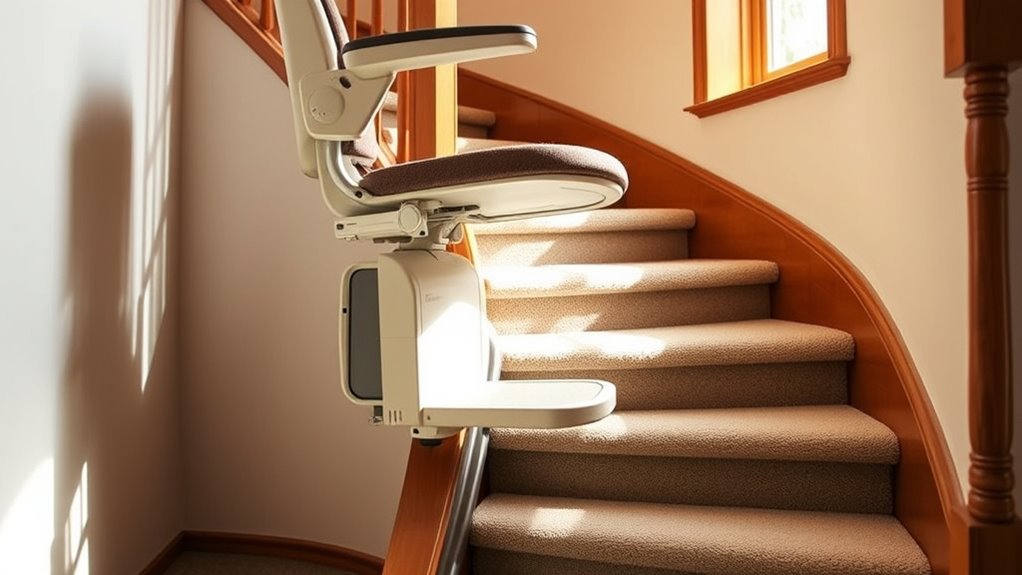
Evaluating power options and battery life is essential to guaranteeing your stairlift remains reliable and convenient. The power source determines how consistently your stairlift operates, especially during power outages. When assessing options, consider these key factors:
- Power options – Choose between mains electricity or rechargeable batteries, depending on your home’s setup and your preference for independence.
- Battery life – Look for models with long-lasting batteries that can handle multiple trips on a single charge.
- Charging mechanism – Ensure the stairlift charges automatically when not in use or can be easily plugged in for quick recharging.
Prioritizing these aspects helps you select a stairlift that’s dependable and fits your daily routine, giving you peace of mind.
Matching Stairlift Features to Your Mobility Requirements
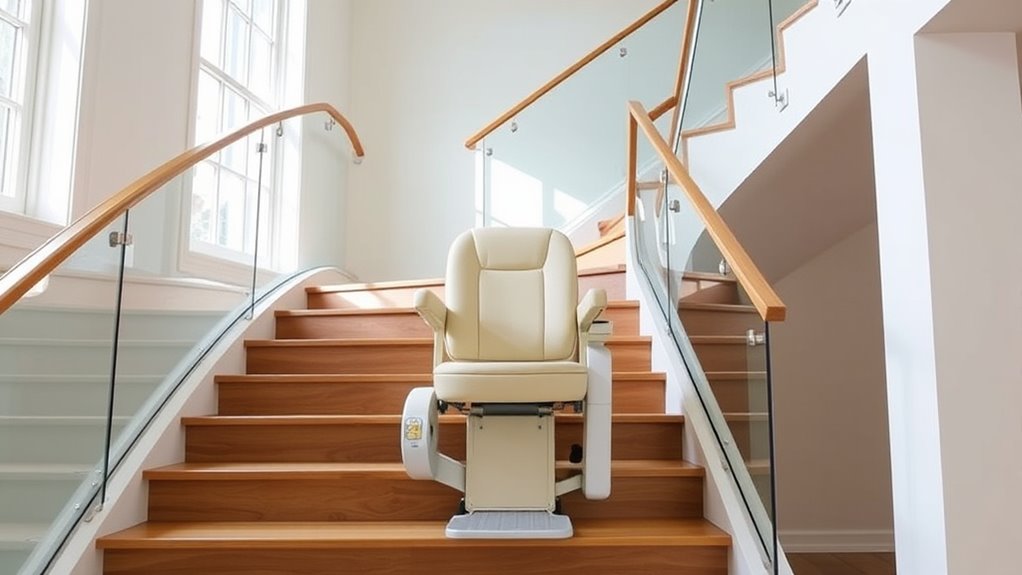
To guarantee your stairlift effectively supports your mobility, it’s important to match its features to your specific needs. Consider how staircase aesthetics align with your home decor—selecting a design that blends seamlessly keeps your space looking good. Focus on user safety features, such as seat belts, sensors, and smooth acceleration, to ensure secure and comfortable rides. If you have limited mobility or balance issues, look for models with easy-to-use controls and sturdy armrests. For longer or more complex staircases, a custom or curved stairlift might be necessary. Matching these features to your mobility requirements helps you choose a stairlift that’s both functional and safe, giving you confidence and convenience every time you use it.
Ensuring Compatibility With Your Home’S Decor
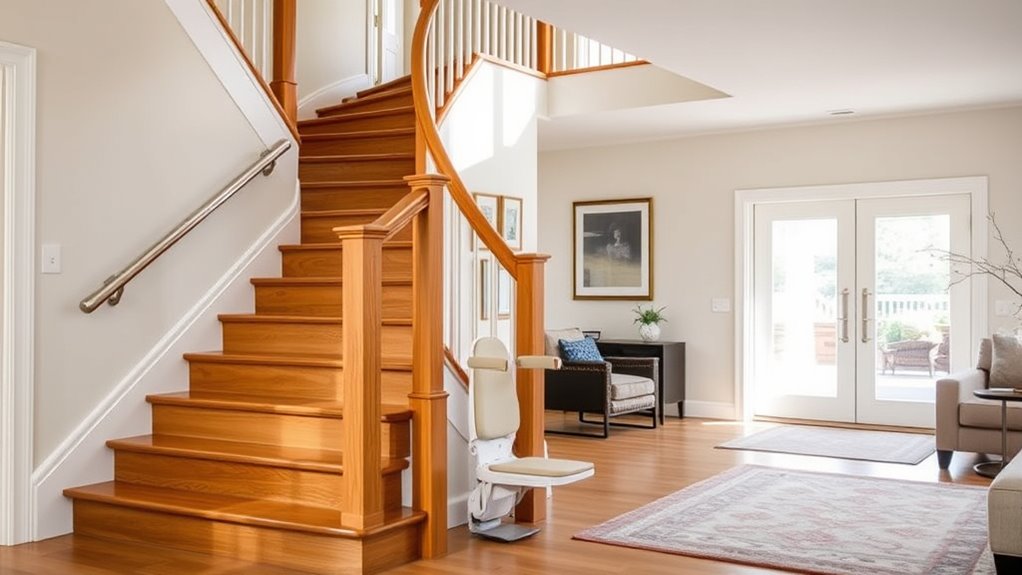
Matching your stairlift features to your mobility needs is essential, but ensuring it blends well with your home’s decor is equally important. You want a solution that offers decor matching and aesthetic integration, so it doesn’t disrupt your space’s style. Consider these key points:
- Choose a design and color that complement your existing interior palette.
- Opt for sleek, discreet models that blend seamlessly into your staircase and walls.
- Use custom options, such as upholstery or finishes, to enhance decor matching and maintain your home’s aesthetic integrity.
Planning for Installation and Maintenance
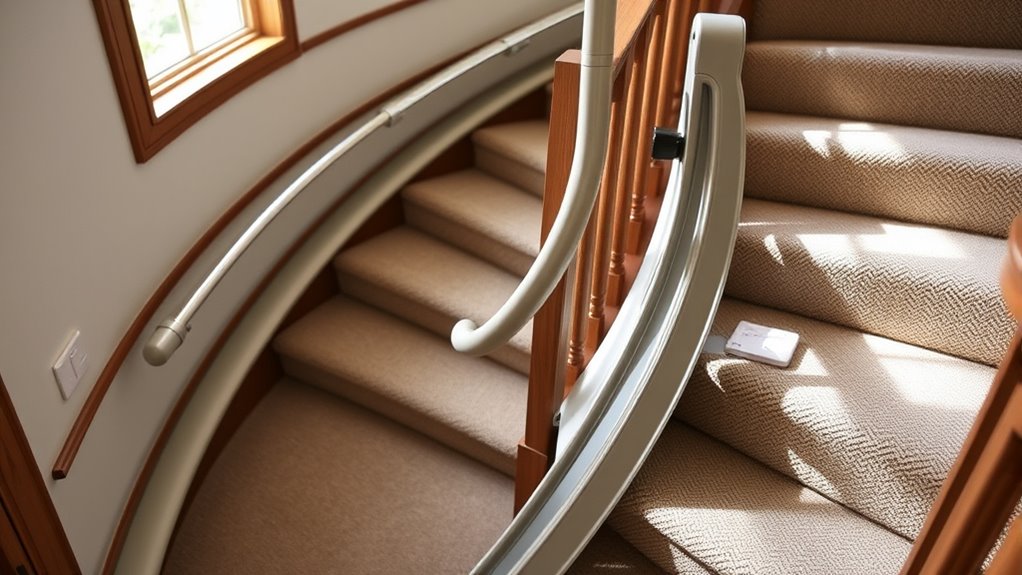
Before installing your stairlift, you’ll need to prepare your space according to site requirements, such as clearing obstacles and ensuring proper power sources. It’s also important to understand the ongoing maintenance needs to keep your stairlift running smoothly. Planning ahead helps you avoid surprises and keeps your stairlift functioning safely for years to come.
Site Preparation Requirements
Proper site preparation is essential for a smooth stairlift installation and ongoing maintenance. Ensuring the area is ready helps guarantee safety precautions are met and user comfort is maximized.
To prepare effectively, consider these key steps:
- Clear the pathway of any obstacles or clutter, providing enough space for safe movement and installation.
- Inspect the staircase for structural stability, making necessary repairs to avoid future issues.
- Confirm the electrical supply meets the stairlift’s requirements, ensuring proper power access and safety.
Ongoing Maintenance Needs
Planning for installation and ongoing maintenance is crucial to guarantee your stairlift functions safely and reliably over time. Regular routine inspections help identify potential issues early, preventing breakdowns and ensuring smooth operation. You should expect periodic checks of the track, motor, and seat to catch any signs of wear or damage. Component replacement may be necessary as parts naturally age or if damage occurs, so staying on top of these upgrades keeps your stairlift in top condition. Proper maintenance also extends the lifespan of your investment and reduces the risk of safety hazards. By scheduling routine inspections and addressing component replacement promptly, you ensure your stairlift remains dependable, providing you with safe, effortless mobility for years to come.
Budgeting for Your Stairlift Investment
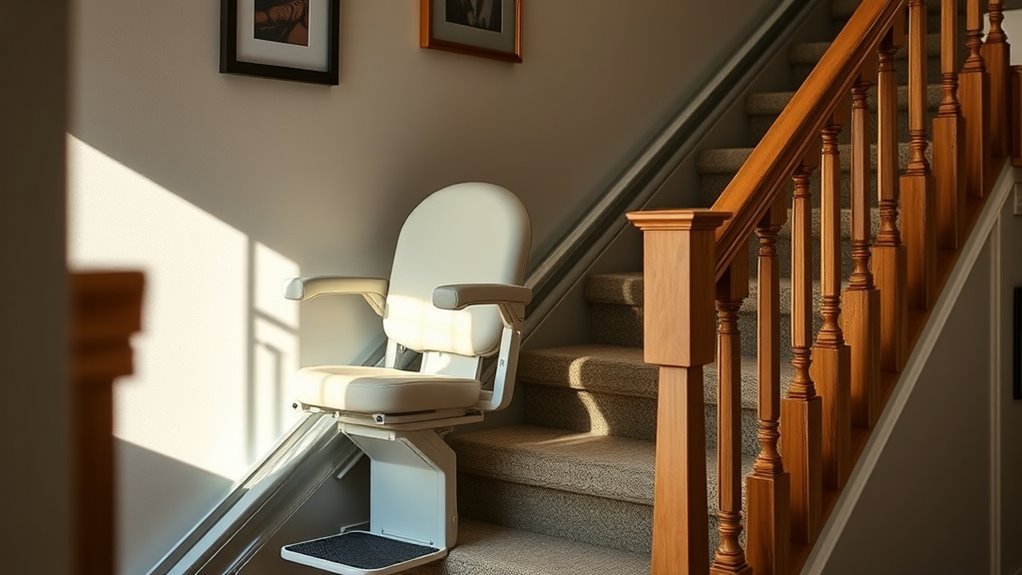
Budgeting for your stairlift investment is a crucial step to guarantee you choose a solution that fits both your needs and financial situation. First, consider the cost considerations, including installation, maintenance, and potential upgrades. Second, explore financing options like payment plans or loans to make the purchase more manageable. Third, set a clear budget based on your financial capacity, balancing quality and affordability. Knowing the total cost helps prevent surprises and ensures you select a stairlift that aligns with your budget. Remember, investing in a stairlift is not just about price but also about long-term value and safety. By planning ahead, you’ll make an informed decision that provides comfort and mobility without straining your finances.
Frequently Asked Questions
What Safety Features Are Included With Different Stairlift Models?
When exploring stairlift options, safety features vary across model options. Many models include seat belts, sensors that detect obstacles, and secure locking mechanisms. Some offer swivel seats for easy mounting, and others have powered footrests for added safety. Always check each model’s safety features to guarantee they meet your needs, so you can feel confident and secure while using your stairlift daily.
Can Stairlifts Be Customized for Unique Staircase Designs?
Did you know that over 60% of homes have unique staircase designs? Stairlifts can indeed be tailored for your home’s specific needs, including curved configurations and custom staircases. You’ll find options like tailored railings and seating to fit your space perfectly. This customization ensures a comfortable, safe ride, regardless of your staircase’s shape or size. So, yes, stairlifts are designed to adapt to your unique staircase setup.
How Long Does Professional Installation Typically Take?
The installation timeline for a stairlift usually takes a few hours, often between 2 to 4 hours, depending on your staircase’s complexity. Scheduling considerations include coordinating with the installer to find a convenient time and ensuring your space is clear. You’ll want to prepare your home ahead of time so the process runs smoothly, allowing you to enjoy your new stairlift quickly and with minimal disruption.
Are There Options for Outdoor Stairlifts?
Yes, there are outdoor stairlift options available. Outdoor installation is designed to withstand weather resistance, so your stairlift can handle rain, snow, and sun. These outdoor models feature durable, weatherproof materials that guarantee safe, reliable operation in the elements. You can enjoy the convenience and safety of a stairlift outside your home, making it easier to access different levels regardless of weather conditions.
What Warranty and After-Sales Support Are Available?
Imagine never worrying about your stairlift breaking down—sounds impossible, right? That’s why top brands offer incredible warranty coverage and dedicated after-sales service that feels like a safety net. You get peace of mind knowing repairs and support are just a call away, ensuring your stairlift keeps running smoothly for years. With reliable warranty and after-sales service, you truly invest in comfort, safety, and long-lasting peace of mind.
Conclusion
Choosing the right stairlift depends on your staircase type, space, and mobility needs. Did you know that over 80% of stairlift users report improved independence and confidence at home? By carefully evaluating your stairs, features, and budget, you can find a model that fits seamlessly into your lifestyle and decor. Investing time now ensures you enjoy safer, easier access every day, making your home more comfortable and accessible for years to come.
